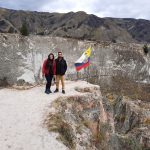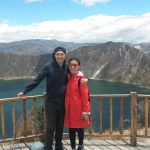CROSSING THE ANDES 5D/4N

Itinerary
Private pickup at the airport, transfer to
your hotel. City by night.
DAY 2
It is a real highlight of the tour that will take your breath away! We will stop at
the base of Cotopaxi Volcano at Limpiopungo Lake to take some pictures and
enjoy the beauty of this place. After we will travel for 2 hours more or less until
Quilotoa Volcano. An turqoise lagoon inside the crater of an extinct volcano
with steep jagged cliffs and views straight down the entire valley of volcanoes.
It is possible to trek into the crater until the lake, if you are tired you can rent a
mule and it will take you back to the top. You can visit a local store where you
can buy some handicrafts. Overnight at Baños.
DAY 3
Free day to relax and enjoy this town.This is a beautiful place
to enjoy the entrance of the Jungle. In this place you can hire a
bike and go to the waterfall or practice stream sports as
Cayoning, Rafting, Swing at the Tree House. Please if you need
help with this service let us know.
DAY 4
Pick up at 8am, transfer to go to Ingapirca Ruins.
The transfer will take more or less 5 hours. You
will have free time at the ruins to visited and after
you will go to Cuenca. The time from Ingapirca to
Cuenca is about 1 hour.
DAY 5
OPTION 1
Free morning to enjoy Cuenca – Transfer from
Cuenca to Guayaquil´s airport.
Finish the Tour
OPTION 2
Free morning to enjoy Cuenca – Transfer to
Cuenca´s airport.
Finish the Tour
Please keep in mind the itinerary is subject to
change in emergency cases.
- Private transportation
- Guide for the city tour
- Spanish speaking driver
- Meals (breakfast every day – lunch day 2 and 4)
- Entrance for the national park Cotopaxi
- 24 hours assistent with local guide by phone
- Entrances
- Extra Meals
- Personal Expenses
- Horse – Kayak or Extra Activities
- Ensurance
- Tips
CONFORT STANDAR
2 PAX $900 $ 750
3 PAX $850 $700
4 PAX $800 $650
COTOPAXI & QUILOTOA 1 DAY TOUR

Itinerary
7:00 am at your hotel (marisacal or old town)
Travel to cotopaxi national park.
Pick up the guide to go inside of the national park
Registration at Cotopaxi national park
Arrive to Limpiopungo lake (free time to visit the lagoon)
Visit the interpretation center
Dropp of the guide
Continue to Rio Toachi cañon
Visit the Rio Toachi cañon
Arrive to Quilotoa
2 hours free to hike until the lake of Quilotoa volcano
Lunch
Transfer back to Quito
PLEASE KEEP IN MIND THAT WE DO NOT HAVE TIME TO MAKE THE TREKKING TO THE VOLCANO COTOPAXI IN THIS TOUR. WE WILL ARRIVE ONLY TO THE BASE OF THE VOLCANO. IF YOU WANT TO HIKE, PLEASE ASK FOR COTOPAXI FULL DAY TOUR.
- Private Transportation
- Registration for Cotopaxi National Park
- Guide for Cotopaxi National Park
- Visits
- Lunch
- Entrance at Quilotoa Volcano
- Personal Expenses
- Breakfast
- Kayak or horse at Quilotoa Volcano
- Tips
GOLONDRINA / BACKPACKER
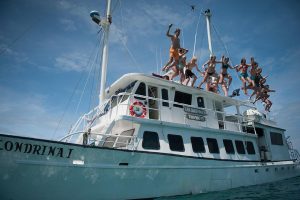
5 Days 4 Nights Northern Islands Galapagos, Monday to Friday
Day 1: Monday
Baltra Island
We land at Baltra Island by plane in the morning and transfer to the dock to board the Santa Cruz II, where we receive a welcome introductory briefing, boat drill and lunch.
Las Bachas (Santa Cruz Island)
This beautiful visitor site is located on the north shore of Santa Cruz Island, a glorious white beach with a couple of brackish lagoons only a few steps away from the sea. These lagoons are the feeding grounds of various wading birds, from stilts to flamingos. You may enjoy swimming and or snorkelling at this beach too. Welcome cocktail, expedition plan for Tuesday and dinner.
Day 2: Tuesday
Buccaneer Cove (Santiago Island)
After breakfast, we explore the coastline along the impressive cliffs of Buccaneer Cove, learning about the area’s distant and recent history. The cove is home to a large number of marine birds, sea lions, and inter-tidal organisms. Enjoy fantastic natural formations such as the “Elephant Rock”, “The Bishop” and an impressive natural cave. Opportunity for snorkelling, and a ride on the panga or glass-bottom boat.
Puerto Egas (Santiago Island)
Once we disembark at the beach, we can enjoy a swim or snorkel amid a rocky shoreline, usually in the company of marine turtles. From here, we head off to our walk, a great opportunity to see land and marine birds amid landscape of tuff-stone layers and lava flows. At low tide, marine iguanas graze upon the algae beds and we can also observe a colony of fur-sea lions. After the visit, we had some time for swimming and snorkelling.
Day 3: Wednesday
Rabida Island (Jervis)
Some groups will go for a fascinating panga ride along the shores while others will disembark on Rabida Island’s red-coloured beach, caused by the unusually high content of iron in the volcanic material. Our walk brings us close to a colony of sea lions, marine iguanas, mockingbirds, yellow warblers and several species of Darwin’s finches. Very close to the beach, a salt pond occasionally hosts American flamingos. This is a great place to snorkel from the beach, both for beginners as well as for experienced snorkelers, due to the unique combination of underwater species and submarine landscapes. During navigation to our next island, we can sometimes spot dolphins!
Bartolome Island
Today’s afternoon activities begin with a wet landing on the golden beach of this famous island, dominated by the imposing Pinnacle Rock. There’s great snorkelling and swimming from the beach plus the chance to ride the glass bottom boat. After returning to the ship, we split into two group: the first lands for a hike to the summit of this diminutive island that boasts fantastic views of the archipelago. This is a moderately steep climb aided by a wooden staircase, resting platforms and handrails – the view from the top is worth the effort! The second takes to the pangas to explore the rugged and volcanic shoreline. The groups then swap so that each one experiences the full beauty of this island.
Day 4: Thursday
Prince Philip Steps (Genovesa Island)
The morning starts with a steep climb (only 90 feet) up some stairs to reach a flat rocky plateau. Along our walk, we can observe large colonies of Nazca boobies, red-footed boobies, great frigate birds and storm petrels. Those not wishing to disembark can enjoy a longer panga ride along the cliffs (depending on weather conditions). Kayaking is optional.
Darwin Bay (Genovesa Island)
In the afternoon, we land at this beautiful beach to enjoy some swimming and/or snorkelling. Following our dip, we take an easy stroll to observe hundreds of birds, mainly frigate birds, red-footed and Nazca boobies, gulls, herons, finches and mockingbirds. Opportunity for snorkelling, kayaking and swimming.
Day 5: Friday
Tortoise Reserve – Baltra airport
We start our last morning at the north shore of Santa Cruz Island. After breakfast, your luggage will be taken to the airport, while you visit the Tortoise Reserve. A dry landing at a passenger’s wharf and a bus ride to the loftier region of the island will provide the last highlight of the cruise: giant tortoises in the wild. The windward slopes of the island are home to two species of giant tortoises. These lush highlands include dense forests of Galapagos daisies, orchids and bromeliads, and several endemic land birds. After this visit we will transfer directly to Baltra airport. Farewell to Galapagos.
5 Days 4 Nights Western Islands Galapagos, Thursday to Monday
Baltra Island
We arrive by plane at Baltra Island and transfer to the dock to board the Santa Cruz II where we receive our welcome introductory briefing, boat drill and lunch.
Cerro Dragón (Dragon Hill) (Santa Cruz Island)
The north shore of Santa Cruz hosts the fascinating landscapes of Cerro Dragón (Dragon Hill). The first part of our walk passes a brackish-water lagoon frequented by shorebirds, ducks and American flamingos, while further inland, the trail offers a beautiful view of the bay and the western islands of the archipelago, as well as the chance of observing land iguanas.
Day 2: Friday
Punta Vicente Roca (Isabela Island)
After breakfast, we explore the coast by panga, while our naturalist guide explains the dramatic geology of the area, a nesting place for several Galapagos highlights: flightless cormorants, Galapagos penguins, fur seals, boobies, etc. Depending on weather conditions, we can snorkel along the cliffs of this area rich in marine life, seasonally-visited by green sea turtles and oceanic sun fish (Mola mola).
Punta Espinoza (Fernandina Island)
The afternoon is dedicated to exploring the youngest island of the archipelago, Fernandina, which, having no introduced mammals, boasts a very unique environment with a very high density of marine iguanas, who share their space with sea lions, Sally light-foot crabs, hawks, penguins and the flightless cormorants.
Day 3: Saturday
Puerto Ayora and the Charles Darwin Research Station (Santa Cruz Island)
In the morning, we disembark (dry landing followed by a brief bus ride) for our visit to the Charles Darwin Research Station’s giant tortoise Breeding Centre within an impressive giant prickly-pear cactus forest, home to many land birds. These are the headquarters of scientific investigation, conservation and the National Park administration. Following our visit, we board our transport to enjoy lunch in the cooler highlands of Santa Cruz Island, a completely different ecosystem.
Santa Cruz Island
We have several options available for the afternoon, which can be discussed in advance with your Expedition Leader. Options include beach walks, kayaks, walks along the tortoise reserve, etc. At the end of the afternoon’s activities, we return to Puerto Ayora and embark on the Santa Cruz II.
Day 4: Sunday
Baroness Tower – Post Office Bay (Floreana Island)
After breakfast, panga ride along the maze of channels on Floreana’s north shore can be enjoyed. We follow this visit by continuing to Baroness Cove with its breathtaking views of Floreana. We land at Post Office Bay to visit the historic barrel that has served as a post office in the archipelago for over two centuries and where postcards are traditionally left for guests from other vessels to hand-deliver to their destinations. Snorkelling off the beach. We then head back on board for lunch.
Champion Islet – Punta Cormorant (Floreana Island)
Following lunch and a siesta, we take the pangas and glass-bottom boat to explore the underwater wonders around Champion Islet, an extinct shield volcano, regarded as one of the best snorkelling spots in the archipelago. From there, it’s on to Punta Cormorant, beginning with a wet landing on the olivine-crystal beach for an easy walk that includes a brackish-water lagoon where bird species such as American flamingos, pintail ducks, common stilts, herons, sandpipers, and others gather. We continue our walk over to a white-sand beach, where sea turtles emerge from the sea at night to nest (from December to May).
Baltra Island
We disembark at Baltra Island in order to transfer to the airport to take the flight back to the mainland.
7 days 6 Nights Eastern Islands Galapagos Friday to Thursday
Baltra Island
We arrive by plane at Baltra Island and transfer to the dock to board the Santa Cruz II where we receive our welcome introductory briefing and lunch.
Mosquera
After lunch and your introductory briefing on board, Santa Cruz II will relocate only four nautical miles from Baltra, next to Mosquera Islet, a small volcanic uplift between Baltra and North Seymour. The island is a long and narrow sand bank surrounded by lava reefs. Our groups will approach the island from its western shore, a long shallow reef, the perfect rookery for young sea lions. After a wet landing, our guides will lead you past the sea lion colonies, where you will learn more about the fragile marine and terrestrial ecosystems of Galapagos. The walk is easy as it is restricted to a few hundred metres of flat sandy dunes. This will also be a great opportunity for an introduction to snorkelling.
Day 2: Saturday
Puerto Baquerizo Moreno (San Cristobal Island)
After breakfast, we disembark (dry landing) at Puerto Baquerizo Moreno, the island’s capital, and drive 40 minutes to the island’s southern shore. At Cerro Colorado, we visit the breeding centre for highly endangered giant tortoises in the midst of a fantastic deciduous forest, home to dozens of bird species, including the San Cristobal mockingbird, and the San Cristobal lava lizard, both island endemics.
Punta Pitt (San Cristobal Island)
In the afternoon, we disembark (wet landing) on the eastern tip of the island at Punta Pitt, an eroded tuff cone, whose trail provides spectacular views of the shoreline. This is the only site in the Galapagos where the three species of boobies can be found together. We can walk or enjoy a panga ride along the coast. Opportunity for snorkelling, swimming and kayaking.
Day 3: Sunday
Santa Fe Island
After breakfast, we take the dinghy over to this idyllic sandy-white beach populated by many sea lions (wet landing). The endemic land iguana, unique to this island, may be spotted during the morning walk amid the giant prickly pear cactus. Snorkelling and swimming from the panga rounds off our rewarding experience, or if guests prefer, the glass bottom boat is available for non-snorkelers. Opportunity for kayaking.
South Plaza Island
Following lunch and a rest, we disembark (dry landing) in this channel, whose turquoise waters contrast brilliantly with the white sand and black lava of the shoreline. Beyond, a carpet of scarlet sesuvium succulents serves as groundcover for a grove of luminescent green prickly-pear cactus. Yellow-grey land iguanas sit beneath these, waiting patiently for pears to drop. Along the coastline one finds sea lion colonies, while frigates, swallow-tailed gulls and shearwaters glide, playing with the thermals.
Day 4: Monday
Puerto Ayora and the Charles Darwin Research Station (Santa Cruz Island)
In the morning, we disembark (dry landing) for our visit to the Charles Darwin Research Station’s giant tortoise Breeding Centre within an impressive giant prickly-pear cactus forest home to many land birds. These are the headquarters of scientific investigation, conservation and the National Park administration. Following our visit, we board our transport to enjoy lunch in the cooler highlands of Santa Cruz Island, a completely different ecosystem.
Santa Cruz Island
We have several options available for the afternoon, which can be discussed in advance with your Expedition Leader. At the end of the afternoon’s activities, we return to Puerto Ayora and embark on the Santa Cruz II.
Day 5: Tuesday
Punta Suarez (Española Island)
(Dry landing) – An exciting walk awaits at this site, where we enjoy its unique sea bird colonies, including Galapagos albatross (April-December), Nazca boobies, blue-footed boobies, and swallow-tailed gulls as well as a view of the Galapagos’ famous “blow-hole”. Also, look out for red-green-black marine iguanas. Back on board for lunch.
Gardner Bay – Osborn Islet (Española Island)
(Wet landing) In the afternoon, the picture-postcard white coral beach of Gardner Bay and the nearby islet of Osborn provides a beautiful setting for observing sea lions, mockingbirds, and finches as we relax. We can expect great snorkelling in this area. Opportunity for swimming and kayaking as well.
Day 6: Wednesday
Eden Islet (Santa Cruz Island)
After breakfast, a panga ride takes us to Eden Islet, a small islet located off the coast of Santa Cruz, where we can observe blue-footed boobies diving into the water, reef sharks and frigates. There’s a chance to snorkel and, if weather condition permits, ride in the glass-bottom boat and kayak.
North Seymour Island
North Seymour was lifted from the ocean floor by a volcanic event, and its origins as a seabed give the island its low, flat profile. A tiny forest of silver-grey Palo Santo trees stands just above the landing (dry landing), usually without leaves, waiting for the rains to burst into bloom. This is a great introductory site to the islands and their wildlife, full of bird colonies of blue footed boobies, two species of frigate birds, swallow-tailed gulls, as well as sea lions and marine iguanas.
Day 7: Thursday
Baltra Island
On our last day, we disembark at Baltra Island and transfer to the airport to take the flight back to the continent.
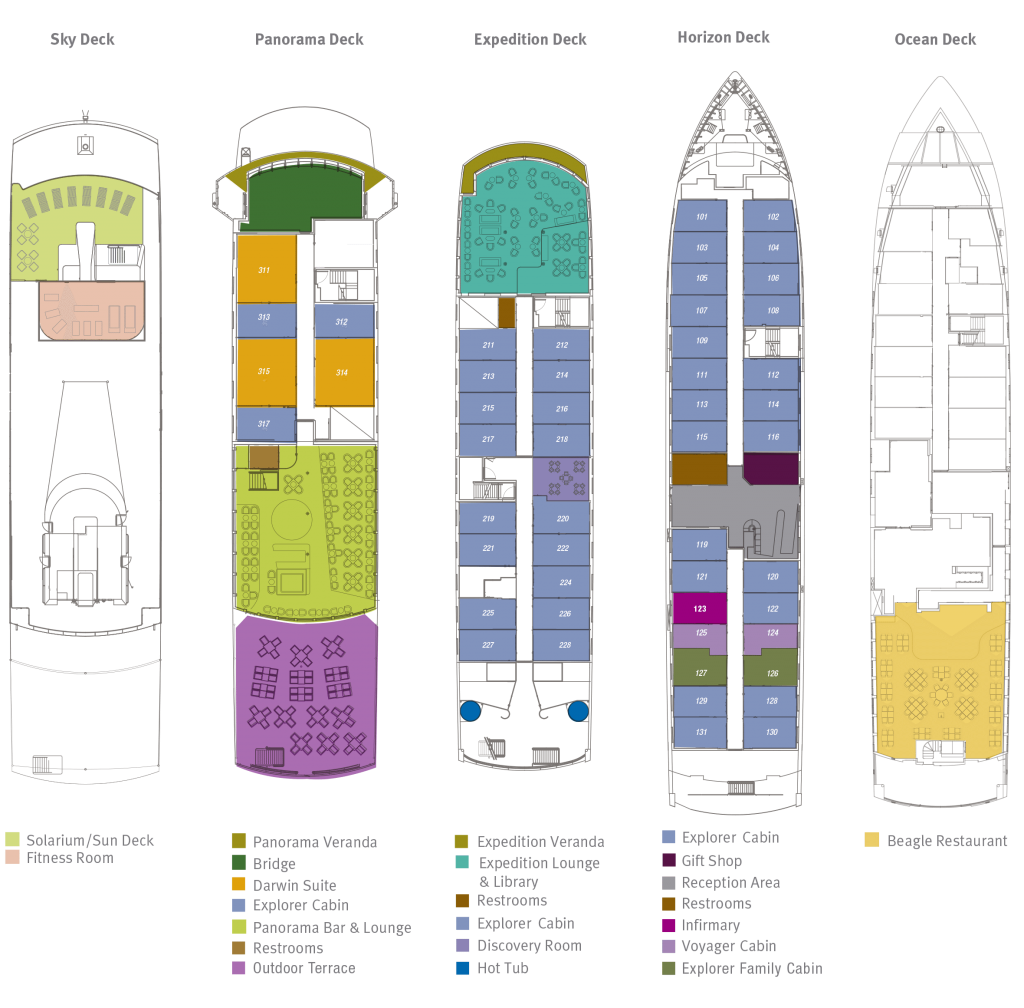
 Conceived for operations in remote areas, our state-of-the-art expedition vessel evinces the perfect infrastructure for Galapagos exploration. Carrying its crew’s heritage of decades of experience working in the islands and just over 70 metres long, the generous, five-deck craft holds 50 cabins for 90 guests and features ample, luxury-sized social areas indoors and out that allow guests to make the most of their Galapagos cruise experience.
Conceived for operations in remote areas, our state-of-the-art expedition vessel evinces the perfect infrastructure for Galapagos exploration. Carrying its crew’s heritage of decades of experience working in the islands and just over 70 metres long, the generous, five-deck craft holds 50 cabins for 90 guests and features ample, luxury-sized social areas indoors and out that allow guests to make the most of their Galapagos cruise experience.
- Refurbishment 2015
- Construction 2002
- Gross Tonnage 2664 tonnes
- Passenger Space Ratio 29.6
- Type of Vessel Expedition Vessel
- Capacity 90 guests / 50 cabins
- Lengh 71.8 m / 235 ft
- Beam 13.4 ms / 43 ft
- Speed 10.5 knots
- Electricity 440V – 220V – 110V throughout ship
- Engines 2 Cummins engines KTA 38 – MO of 850 HP each
- Fire Detector Fire detectors throughout
- Life Jackets In each cabin
- Life Rafts 14 (For 27 passengers each)
- Landing Boats 6
- Owner ETICA (METROPOLITAN TOURING)
- Decks 5
- Crew 60
- Naturalist Guides 8 (Includes Expedition Leader)
- Guest-Crew Ratio 3:2 (3 guests per 2 crew members)
- Medial Officer Permanently on board
- Certifications ABS, SOLAS 74, ISM, ISPS, MARPOL
- Panorama Deck 3 Darwin Suites, 3 Explorer Cabins
- Expedition Deck 17 Explorer Cabins
- Horizon Deck 2 Voyager Cabins, 2 Explorer Family Cabins, 23 Explorer Cabins, infirmary.
ISABELLA / FIRST CLASS
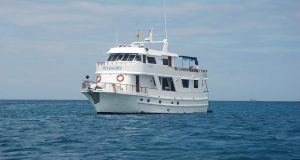
5 Days 4 Nights Northern Islands Galapagos, Monday to Friday
Day 1: Monday
Baltra Island
We land at Baltra Island by plane in the morning and transfer to the dock to board the Santa Cruz II, where we receive a welcome introductory briefing, boat drill and lunch.
Las Bachas (Santa Cruz Island)
This beautiful visitor site is located on the north shore of Santa Cruz Island, a glorious white beach with a couple of brackish lagoons only a few steps away from the sea. These lagoons are the feeding grounds of various wading birds, from stilts to flamingos. You may enjoy swimming and or snorkelling at this beach too. Welcome cocktail, expedition plan for Tuesday and dinner.
Day 2: Tuesday
Buccaneer Cove (Santiago Island)
After breakfast, we explore the coastline along the impressive cliffs of Buccaneer Cove, learning about the area’s distant and recent history. The cove is home to a large number of marine birds, sea lions, and inter-tidal organisms. Enjoy fantastic natural formations such as the “Elephant Rock”, “The Bishop” and an impressive natural cave. Opportunity for snorkelling, and a ride on the panga or glass-bottom boat.
Puerto Egas (Santiago Island)
Once we disembark at the beach, we can enjoy a swim or snorkel amid a rocky shoreline, usually in the company of marine turtles. From here, we head off to our walk, a great opportunity to see land and marine birds amid landscape of tuff-stone layers and lava flows. At low tide, marine iguanas graze upon the algae beds and we can also observe a colony of fur-sea lions. After the visit, we had some time for swimming and snorkelling.
Day 3: Wednesday
Rabida Island (Jervis)
Some groups will go for a fascinating panga ride along the shores while others will disembark on Rabida Island’s red-coloured beach, caused by the unusually high content of iron in the volcanic material. Our walk brings us close to a colony of sea lions, marine iguanas, mockingbirds, yellow warblers and several species of Darwin’s finches. Very close to the beach, a salt pond occasionally hosts American flamingos. This is a great place to snorkel from the beach, both for beginners as well as for experienced snorkelers, due to the unique combination of underwater species and submarine landscapes. During navigation to our next island, we can sometimes spot dolphins!
Bartolome Island
Today’s afternoon activities begin with a wet landing on the golden beach of this famous island, dominated by the imposing Pinnacle Rock. There’s great snorkelling and swimming from the beach plus the chance to ride the glass bottom boat. After returning to the ship, we split into two group: the first lands for a hike to the summit of this diminutive island that boasts fantastic views of the archipelago. This is a moderately steep climb aided by a wooden staircase, resting platforms and handrails – the view from the top is worth the effort! The second takes to the pangas to explore the rugged and volcanic shoreline. The groups then swap so that each one experiences the full beauty of this island.
Day 4: Thursday
Prince Philip Steps (Genovesa Island)
The morning starts with a steep climb (only 90 feet) up some stairs to reach a flat rocky plateau. Along our walk, we can observe large colonies of Nazca boobies, red-footed boobies, great frigate birds and storm petrels. Those not wishing to disembark can enjoy a longer panga ride along the cliffs (depending on weather conditions). Kayaking is optional.
Darwin Bay (Genovesa Island)
In the afternoon, we land at this beautiful beach to enjoy some swimming and/or snorkelling. Following our dip, we take an easy stroll to observe hundreds of birds, mainly frigate birds, red-footed and Nazca boobies, gulls, herons, finches and mockingbirds. Opportunity for snorkelling, kayaking and swimming.
Day 5: Friday
Tortoise Reserve – Baltra airport
We start our last morning at the north shore of Santa Cruz Island. After breakfast, your luggage will be taken to the airport, while you visit the Tortoise Reserve. A dry landing at a passenger’s wharf and a bus ride to the loftier region of the island will provide the last highlight of the cruise: giant tortoises in the wild. The windward slopes of the island are home to two species of giant tortoises. These lush highlands include dense forests of Galapagos daisies, orchids and bromeliads, and several endemic land birds. After this visit we will transfer directly to Baltra airport. Farewell to Galapagos.
5 Days 4 Nights Western Islands Galapagos, Thursday to Monday
Baltra Island
We arrive by plane at Baltra Island and transfer to the dock to board the Santa Cruz II where we receive our welcome introductory briefing, boat drill and lunch.
Cerro Dragón (Dragon Hill) (Santa Cruz Island)
The north shore of Santa Cruz hosts the fascinating landscapes of Cerro Dragón (Dragon Hill). The first part of our walk passes a brackish-water lagoon frequented by shorebirds, ducks and American flamingos, while further inland, the trail offers a beautiful view of the bay and the western islands of the archipelago, as well as the chance of observing land iguanas.
Day 2: Friday
Punta Vicente Roca (Isabela Island)
After breakfast, we explore the coast by panga, while our naturalist guide explains the dramatic geology of the area, a nesting place for several Galapagos highlights: flightless cormorants, Galapagos penguins, fur seals, boobies, etc. Depending on weather conditions, we can snorkel along the cliffs of this area rich in marine life, seasonally-visited by green sea turtles and oceanic sun fish (Mola mola).
Punta Espinoza (Fernandina Island)
The afternoon is dedicated to exploring the youngest island of the archipelago, Fernandina, which, having no introduced mammals, boasts a very unique environment with a very high density of marine iguanas, who share their space with sea lions, Sally light-foot crabs, hawks, penguins and the flightless cormorants.
Day 3: Saturday
Puerto Ayora and the Charles Darwin Research Station (Santa Cruz Island)
In the morning, we disembark (dry landing followed by a brief bus ride) for our visit to the Charles Darwin Research Station’s giant tortoise Breeding Centre within an impressive giant prickly-pear cactus forest, home to many land birds. These are the headquarters of scientific investigation, conservation and the National Park administration. Following our visit, we board our transport to enjoy lunch in the cooler highlands of Santa Cruz Island, a completely different ecosystem.
Santa Cruz Island
We have several options available for the afternoon, which can be discussed in advance with your Expedition Leader. Options include beach walks, kayaks, walks along the tortoise reserve, etc. At the end of the afternoon’s activities, we return to Puerto Ayora and embark on the Santa Cruz II.
Day 4: Sunday
Baroness Tower – Post Office Bay (Floreana Island)
After breakfast, panga ride along the maze of channels on Floreana’s north shore can be enjoyed. We follow this visit by continuing to Baroness Cove with its breathtaking views of Floreana. We land at Post Office Bay to visit the historic barrel that has served as a post office in the archipelago for over two centuries and where postcards are traditionally left for guests from other vessels to hand-deliver to their destinations. Snorkelling off the beach. We then head back on board for lunch.
Champion Islet – Punta Cormorant (Floreana Island)
Following lunch and a siesta, we take the pangas and glass-bottom boat to explore the underwater wonders around Champion Islet, an extinct shield volcano, regarded as one of the best snorkelling spots in the archipelago. From there, it’s on to Punta Cormorant, beginning with a wet landing on the olivine-crystal beach for an easy walk that includes a brackish-water lagoon where bird species such as American flamingos, pintail ducks, common stilts, herons, sandpipers, and others gather. We continue our walk over to a white-sand beach, where sea turtles emerge from the sea at night to nest (from December to May).
Baltra Island
We disembark at Baltra Island in order to transfer to the airport to take the flight back to the mainland.
7 days 6 Nights Eastern Islands Galapagos Friday to Thursday
Baltra Island
We arrive by plane at Baltra Island and transfer to the dock to board the Santa Cruz II where we receive our welcome introductory briefing and lunch.
Mosquera
After lunch and your introductory briefing on board, Santa Cruz II will relocate only four nautical miles from Baltra, next to Mosquera Islet, a small volcanic uplift between Baltra and North Seymour. The island is a long and narrow sand bank surrounded by lava reefs. Our groups will approach the island from its western shore, a long shallow reef, the perfect rookery for young sea lions. After a wet landing, our guides will lead you past the sea lion colonies, where you will learn more about the fragile marine and terrestrial ecosystems of Galapagos. The walk is easy as it is restricted to a few hundred metres of flat sandy dunes. This will also be a great opportunity for an introduction to snorkelling.
Day 2: Saturday
Puerto Baquerizo Moreno (San Cristobal Island)
After breakfast, we disembark (dry landing) at Puerto Baquerizo Moreno, the island’s capital, and drive 40 minutes to the island’s southern shore. At Cerro Colorado, we visit the breeding centre for highly endangered giant tortoises in the midst of a fantastic deciduous forest, home to dozens of bird species, including the San Cristobal mockingbird, and the San Cristobal lava lizard, both island endemics.
Punta Pitt (San Cristobal Island)
In the afternoon, we disembark (wet landing) on the eastern tip of the island at Punta Pitt, an eroded tuff cone, whose trail provides spectacular views of the shoreline. This is the only site in the Galapagos where the three species of boobies can be found together. We can walk or enjoy a panga ride along the coast. Opportunity for snorkelling, swimming and kayaking.
Day 3: Sunday
Santa Fe Island
After breakfast, we take the dinghy over to this idyllic sandy-white beach populated by many sea lions (wet landing). The endemic land iguana, unique to this island, may be spotted during the morning walk amid the giant prickly pear cactus. Snorkelling and swimming from the panga rounds off our rewarding experience, or if guests prefer, the glass bottom boat is available for non-snorkelers. Opportunity for kayaking.
South Plaza Island
Following lunch and a rest, we disembark (dry landing) in this channel, whose turquoise waters contrast brilliantly with the white sand and black lava of the shoreline. Beyond, a carpet of scarlet sesuvium succulents serves as groundcover for a grove of luminescent green prickly-pear cactus. Yellow-grey land iguanas sit beneath these, waiting patiently for pears to drop. Along the coastline one finds sea lion colonies, while frigates, swallow-tailed gulls and shearwaters glide, playing with the thermals.
Day 4: Monday
Puerto Ayora and the Charles Darwin Research Station (Santa Cruz Island)
In the morning, we disembark (dry landing) for our visit to the Charles Darwin Research Station’s giant tortoise Breeding Centre within an impressive giant prickly-pear cactus forest home to many land birds. These are the headquarters of scientific investigation, conservation and the National Park administration. Following our visit, we board our transport to enjoy lunch in the cooler highlands of Santa Cruz Island, a completely different ecosystem.
Santa Cruz Island
We have several options available for the afternoon, which can be discussed in advance with your Expedition Leader. At the end of the afternoon’s activities, we return to Puerto Ayora and embark on the Santa Cruz II.
Day 5: Tuesday
Punta Suarez (Española Island)
(Dry landing) – An exciting walk awaits at this site, where we enjoy its unique sea bird colonies, including Galapagos albatross (April-December), Nazca boobies, blue-footed boobies, and swallow-tailed gulls as well as a view of the Galapagos’ famous “blow-hole”. Also, look out for red-green-black marine iguanas. Back on board for lunch.
Gardner Bay – Osborn Islet (Española Island)
(Wet landing) In the afternoon, the picture-postcard white coral beach of Gardner Bay and the nearby islet of Osborn provides a beautiful setting for observing sea lions, mockingbirds, and finches as we relax. We can expect great snorkelling in this area. Opportunity for swimming and kayaking as well.
Day 6: Wednesday
Eden Islet (Santa Cruz Island)
After breakfast, a panga ride takes us to Eden Islet, a small islet located off the coast of Santa Cruz, where we can observe blue-footed boobies diving into the water, reef sharks and frigates. There’s a chance to snorkel and, if weather condition permits, ride in the glass-bottom boat and kayak.
North Seymour Island
North Seymour was lifted from the ocean floor by a volcanic event, and its origins as a seabed give the island its low, flat profile. A tiny forest of silver-grey Palo Santo trees stands just above the landing (dry landing), usually without leaves, waiting for the rains to burst into bloom. This is a great introductory site to the islands and their wildlife, full of bird colonies of blue footed boobies, two species of frigate birds, swallow-tailed gulls, as well as sea lions and marine iguanas.
Day 7: Thursday
Baltra Island
On our last day, we disembark at Baltra Island and transfer to the airport to take the flight back to the continent.

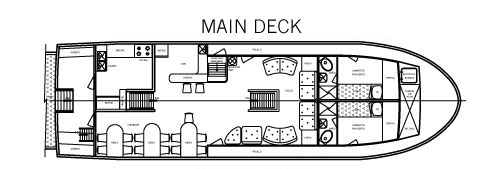

General informations
Name: Darwin Yacht
Construction Year: 1995
Place of Construction: Puerto Ayora – Galapagos – Ecuador
Technical specifications
| Type | Motor vessel |
| Category | Superior Turist |
| Capacity | 16 People |
| Length | 60 feet |
| bean | 18 feet |
| Speed | 9 knots |
| Crew | 6 people + 1 English Speaking Naturalist Gide |
Accommodations and facilities
8 Double Cabins with air conditioning, private bathroom and hot / could water
LA PINTA / LUXUARY

Eastern Galapagos Itinerary 5 Days 4 Nights
Baltra Airport
Our adventure begins with a morning flight to Baltra Island and immediate transfer to the dock to board Yacht La Pinta. There’s a welcome introductory briefing, boat drill, cabin assignment and then lunch. We weigh anchor and start sailing for our first afternoon outing.
South Plaza Island
The turquoise waters of the channel here contrast brilliantly with the white sand and black lava of the shoreline, while a carpet of scarlet sesuvium succulents serves as groundcover for a grove of luminescent green prickly-pear cactus beyond, populated by yellow-grey land iguanas. Along the coastline one finds sea lion colonies, while sea birds play with the thermals that form along the cliffs of this small but spectacular island.
Day 2: Friday
Santa Fe Island
We take the dinghy over to this idyllic sandy-white beach populated by colonies of sea lions. Galapagos hawks are often easily observed, perched atop salt bushes. The Santa Fe land iguana, unique to just this island, may be spotted during the walk. Following the walk, we can snorkel and swim along a natural wave barrier or ride the glass-bottom boat.
Cerro Colorado Tortoise Habitat
After lunch, we disembark at Puerto Baquerizo Moreno, the island’s capital, and drive 40 minutes to the island’s southern shore. At Cerro Colorado, we visit the breeding centre for highly endangered giant tortoises in the midst of a fantastic deciduous forest, home to dozens of bird species, including the San Cristobal mockingbird, and the San Cristobal lava lizard, both island endemics.
Day 3: Saturday
Punta Pitt (San Cristobal Island)
We land at the eastern tip of San Cristobal Island this morning. The trail that ascends from the beach provides spectacular views of the shoreline; we can observe frigates, plus a colony of bachelor sea lions. After the walk, if conditions are favourable, there is a chance to swim from the beach and snorkel.
Cerro Brujo
In the afternoon following lunch on board, a dinghy ride along the shores of tuff-stone layers takes us to Cerro Brujo’s expansive, white coral beach, great for walking, with rewarding bird-watching featuring seabirds and shore birds. Also, look out for Galapagos sea lions. These are the same shores that Charles Darwin walked upon, back in September 1835.
Day 4: Sunday
Punta Suarez
Our morning outing at Punta Suárez provides an exciting walk on lava/boulder terrain to visit its unique sea bird colonies, including the waved albatrosses (April – January), boobies, swallow-tail gulls, and the famous “blowhole” lava formation. Also, look for red-green-black marine iguanas. Many regard this site as the best in the Galapagos. Back on board for lunch.
Gardner Bay
In the afternoon, we set down at this beautiful, white coral beach for a short walk to observe the sea lions, mockingbirds, finches, or enjoy the beach. There is great snorkelling in this area, or else there’s time to kayak or ride the glass-bottom boat.
Day 5: Monday
Charles Darwin Research Station (Santa Cruz Island)/ Baltra Airport
Disembarking in the morning, we visit the Charles Darwin Research Station and the captive rearing programme for the giant tortoises. Here we witness the efforts and results of Galapagos fieldwork and study done in the name of science. We transfer via bus across Santa Cruz Island and a short ferry ride to Baltra. Our journey ends at Baltra Island, where we transfer to the airport to take the flight back to the mainland. Baltra’s flat substrate (due to its uplifted origin) is the reason why the island was chosen back in the 1940s as the construction site for an airport.
Northern Galapagos Itinerary 5 Days 4 Nights
Day 1: Monday
Baltra Airport
Following our morning arrival at Baltra Airport, we transfer to the Itabaca Channel, taking a small ferry across the channel to the north shore of Santa Cruz Island. We board our bus to the highlands, where we’ll learn about Santa Cruz’s unique ecosystems and biodiversity. Lunch is served at a local restaurant.
Highlands (Santa Cruz Island)
After lunch, we continue by bus to reach a reserve that is one of the best places in the archipelago to see giant tortoises in their natural habitat. The tortoises are easy to spot, lumbering around, eating grass and leaves and wallowing in the small pools. There are several lava tunnels in the reserve, too. A short bus ride takes us down to Puerto Ayora to board Yacht La Pinta.
Day 2: Tuesday
Eden Islet (Santa Cruz Island)
After breakfast, a panga ride takes us to Eden Islet, located off the coast of Santa Cruz, where we can observe blue footed boobies diving into the water, reef sharks and frigates. There’s a chance to snorkel and, if weather conditions permit, to ride in the glass-bottom boat. The volcanic setting of this area is quite stunning due to its variety of volcanic debris, including cinder cones, tuff cones, and semi-eroded lava flows.
Sombrero Chino Islet
The tiny island of Sombrero Chino gets its name from its appearance, reminiscent of a Chinese hat. This islet, formed only fairly recently, makes a beautiful visit as one explores the wildlife along its 400-metre long trail, which begins at a crescent-shaped white sandy beach. The cove offers excellent swimming and snorkelling opportunities amid white-tipped reef sharks and Galapagos penguins.
Day 3: Wednesday
Bartolome Island
This morning, a Galapagos icon awaits: Bartolome Island. A great way to start the day, with a steep climb up a wooden staircase: the view from the top is worth the effort! Following the walk, we take to the dinghies for a ride around colossal Pinnacle Rock, followed by time to enjoy the beach and some snorkelling. We can also ride in the glass-bottom boat for great views of the underwater world.
Sullivan Bay (Santiago Island)
After lunch, we board the pangas to land at Sullivan Bay on the east coast of Santiago, a white coral sand beach great for swimming and snorkelling, and with a trail over a lava field that flowed here less than 100 years ago. This is the perfect place to see and feel the volcanic origin of Galapagos while observing its wildlife.
Day 4: Thursday
Darwin Bay
In the morning, we begin our exploration of this island with an easy stroll to observe marine and land birds. There is an optional walk over sharp lava and uneven terrain for dramatic views, or else we can return to the beach to enjoy swimming and snorkelling at this beautiful natural harbour. The more adventurous can snorkel along the cliffs or paddle sea kayaks.
Prince Philip’s Steps (Genovesa Island)
The afternoon starts with a very interesting panga ride along the cliffs before we disembark for a short but steep climb up a wooden staircase. Once at the top, the land is flat, allowing for a captivating walk of about a mile to the other side of this small island, observing large colonies of Nazca boobies, frigate birds and storm petrels and the elusive short eared owl.
Day 5: Friday
Baltra Island
Our journey ends at Baltra Island, where we transfer to the airport to take the flight back to the mainland. Baltra’s flat substrate (due to its uplifted origin) is the reason why the island was chosen back in the 1940s as the location to building an airport
Western Galapagos Itinerary 7 Days 6 Nights
Baltra Island
Our adventure begins with a morning flight to Baltra Island and immediate transfer to the dock to board Yacht La Pinta. There’s an introductory welcome briefing, boat drill, cabin assignment followed by lunch.
North Seymour Island
Following an afternoon disembarkation, we enjoy a walk along the coast and the interior of this beautiful flat island, observing numerous bird colonies as well as sea lions and land iguanas. There are opportunities for coastal exploration by dinghy. Evening briefing, welcome cocktail and dinner.
Day 2: Saturday
Punta Vicente Roca (Isabela Island)
Since there is no landing site at this location, the coastal exploration is by panga, while the naturalist guide explains the dramatic geology of the area, with remains of lava flows and tuff stone layers. There is abundant wildlife and, depending on the conditions of the ocean, we’ll be able to snorkel along the cliffs, hopefully in the company of green sea turtles.
Punta Espinoza (Fernandina Island)
In the afternoon, we visit the youngest and most pristine island of the archipelago, Fernandina, one of many visitors’ all-time favourites. Punta Espinoza has an amazing combination of barrenness and abundant wildlife. Highlights include hawks, penguins, flightless cormorants and astounding views of the surrounding volcanic landscapes.
Day 3: Sunday
Urbina Bay (Isabela Island)
After breakfast, we disembark at Urbina Bay, on the western side of Isabela Island, the result of an uplifting of the ocean floor. Here you can see corals, shells, and large and very colourful Galapagos land iguanas, as well as (occasionally) giant tortoises. Navigating the Bolívar Channel, there are good chances of spotting several species of whales.
Tagus Cove (Isabela Island)
On the northwest of Isabela, secluded Tagus Cove provided a favourite anchorage for pirates and whalers over the centuries, and today makes a great visitor site. An uphill hike takes us to the back of Darwin Crater, filled with salt water. We can snorkel or ride kayaks amid the dramatic landscape before going on our hike.
Day 4: Monday
Rabida Island
In the morning, we disembark at Rabida Island’s red-coloured beach. A stroll along the beach allows us to observe marine iguanas, mockingbirds, yellow warblers and several species of Darwin’s finches. This is a great place to snorkel from the beach. For non-snorkelers, we can ride our glass-bottom boat for an exploration of life underneath the waves.
Cerro Dragon (Dragon Hill) (Santa Cruz Island)
The north shore of Santa Cruz hosts the fascinating landscapes of Cerro Dragon (Dragon Hill). Our walk includes circling a brackish water lagoon frequented by lagoon birds, while further inland, the trail offers a beautiful view of the bay and the western islands of the archipelago, as well as the chance to observe land iguanas.
Day 5: Tuesday
Puerto Ayora & Charles Darwin Research Station
The morning visit heads to the Charles Darwin Research Station and the giant tortoise pens within an impressive giant prickly-pear cactus forest. These are the Galapagos’ headquarters of scientific investigation, conservation and the National Park administration. A delicious lunch is served at the poolside of the Finch Bay Eco Hotel.
Highlands of Santa Cruz Island
After lunch, we head up to the highlands of Santa Cruz Island by vehicle. This is a great place to look for the emblematic Darwin’s Finches and the endemic Scalesia trees. The highlands are also great for exploring the exuberant vegetation where giant tortoises roam in the wild. This will surely be one of the most remembered visits of the whole voyage.
Day 6: Wednesday
Post Office Bay (Floreana Island)
After breakfast, we land at Post Office Bay (Floreana Island) to visit the historic barrel that has served as a post office in the archipelago for over two centuries. Panga rides along the maze of channels on Floreana’s north shore can also be enjoyed. Views from La Lobería and the Baroness Viewpoint are quite rewarding. There’s great kayaking and swimming from the beach as well.
Champion Islet & Punta Cormorant (Floreana Island)
Before disembarking at Punta Cormorant we can snorkel or ride our glass-bottom boat along the coast of an extinct cone called “Champion Islet”. Later in the afternoon, our visit to Punta Cormorant takes in an olivine-crystal beach for an easy walk by a brackish water lagoon where bird species like American flamingos may be observed. On the other side of the island, we come to a white-sand beach where sea turtles come out at night to nest.
Day 7: Thursday
Baltra Island
Our journey ends at Baltra Island, where we transfer to the airport to take the flight back to the mainland. Baltra’s flat substrate (due to its uplifted origin) is the reason why the island was chosen back in the 1940s as the location to building an airport.
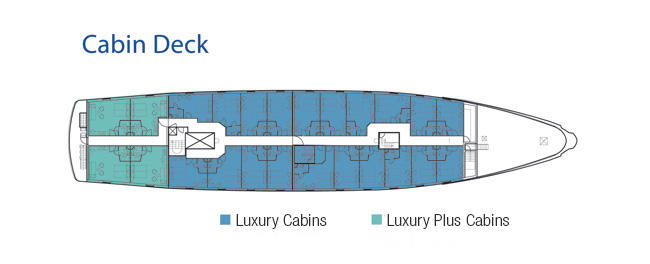


- Reconstruted & refitted: Callao, Peru in 2007
- Length: 63.87 metres (209 ft.)
- Beam: 12.50 metres (41 ft.)
- Gross Tonnage: 1,438.25 tons
- Speed: 10 knots
- Capacity: 48 guests
- Cabin: 24 outside cabins, on the same Deck with twin or queen-size beds
- Double Cabin size: 16 square metres (175 square feet)
- Triple cabin size: 22 square metres (236 square feet) with sofa bed
- Decks: Three public decks include an ample Bar-salon, dining room, natural history library, sky bar and sundeck
- Wellness: Jacuzzi, Fitness room
- Type of Vessel: Motor Yacht
- Electricity: 110-220 volts 50Hz
- Engines: 2 DEUTZ Model SBA 8M 1275 HP
- Navigation Equipment: Gyrocompass, Automatic Pilot, radar and GPS
- Communications Systems: Inmarsat C, Satellite Internet
- Safety Certificates: SOLAS, STCW, MARPOL, ISM CODE 12
- Fire Detector: Automatic with control from the bridge
- Life Jackets: In each cabin
- Inflatable Life Craft: 2 x 50-man and 6 x 25-man
- Landing Craft: 4 Pumar inflatable craft + glass bottom boat
- Owner: ETICA (Metropolitan Touring)
- Decks: 3 (Sun Deck, Cabin Deck, Main Deck)
- Crew: 27 (Including officers)
- Naturalist Guides: 4 (including Expedition Manager)
- Medical Officer: Permanently on board
SAMBA / MIDRANGE

Itinerary
| SOUTH ITINERARY, EAST AND CENTRAL ISLANDS | ||
| TUE | AM | Baltra: Arrival in Baltra Airport and Transfer to the boat |
| PM | Santa Cruz Island: Charles Darwin St./ Tortoise Breeding Center | |
| WED | AM | Floreana Island: Cormorant Point Floreana Island: Champion Islet |
| PM | Floreana Island: Post Office Bay Floreana Island: Baroness Viewing Point |
|
| THU | AM | Española Island: Suarez Point |
| PM | Española Island: Gardner Bay/Islet | |
| FRI | AM | San Cristobal Island: Lobos Island San Cristobal Island: Kicker Rock |
| PM | San Cristobal Island: Pitt Point | |
| SAT | AM | Santa Fe Island: Barrington Bay South Plaza Island |
| PM | Santa Cruz Island: Carrion Point | |
| SUN | AM | Santiago Island: Sullivan Bay |
| PM | Bartholomew Island | |
| MON | AM | Santiago Island: James Bay |
| PM | Rabida Island | |
| TUE
|
AM | North Seymour Island Baltra: Transfer to the Baltra Airport |
| NORTH ITINERARY AND WESTERN ISLANDS | ||
| TUE | AM | Baltra: Arrival in Baltra Airport and Transfer to the boat |
| PM | Santa Cruz Island: Bachas Beach | |
| WED | AM | Genovesa Island: Darwin Bay |
| PM | Genovesa Island: Prince Phillip’s Steps | |
| THU | AM | Marchena Island: Mejia Point |
| PM | Marchena Island: Black Beach | |
| FRI | AM | Isabela Island: Albemarle Point |
| PM | Isabela Island: Vicente Roca Point | |
| SAT | AM | Fernandina Island: Espinosa Point |
| PM | Isabela Island: Urbina Bay | |
| SUN | AM | Isabela Island: Elizabeth Bay |
| PM | Isabela Island: Moreno Point | |
| MON | AM | Floreana Island: Asilo de la Paz |
| PM | Floreana Island: Lobería | |
| TUE | AM | Santa Cruz Island: Highlands Baltra: Transfer to the Baltra Airport |

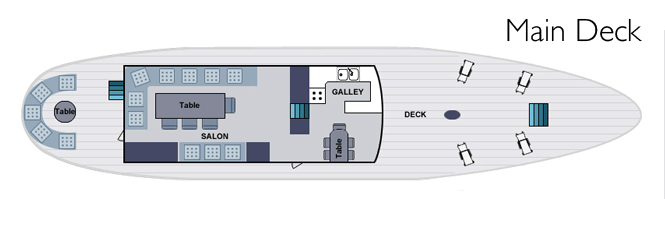

| TECHNICAL SPECIFICATIONS | |
| Year of construction: | 1966 |
| Type: | Sailor |
| Category: | |
| Length: | 78fts / 24mts |
| Beam: | 18fts / 5mts |
| Capacity: | 14 passengers |
| Accommodation: |
|
| On Board: | salon and an outdoor dining area, observation deck/sun deck, TV and VCR room |
| Main engines: | Twin DAV diesel engines 220 HP |
| Max speed: | 9 knots |
| Crew: | Captain, mechanic, cook, 2 sailors and 1 naturalist guide |
| Safety & Navigation: | One self-contained 20-passenger life raft, EPIRB (Emergency Positioning Indicating Radio Beacon), Two bi-directional VHF emergency-radios, VHF (Motorola) wide-range radio |










